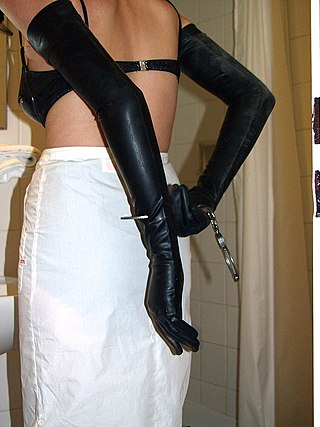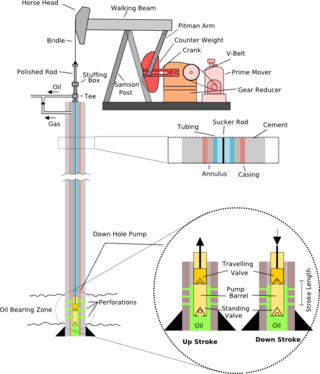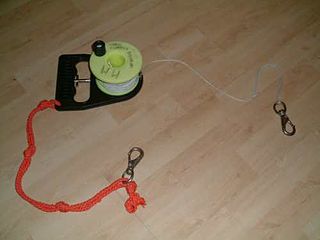
BDSM is a variety of often erotic practices or roleplaying involving bondage, discipline, dominance and submission, sadomasochism, and other related interpersonal dynamics. Given the wide range of practices, some of which may be engaged in by people who do not consider themselves to be practising BDSM, inclusion in the BDSM community or subculture often is said to depend on self-identification and shared experience.

Bondage, in the BDSM subculture, is the practice of consensually tying, binding, or restraining a partner for erotic, aesthetic, or somatosensory stimulation. A partner may be physically restrained in a variety of ways, including the use of rope, cuffs, bondage tape, or self-adhering bandage.

Self-bondage refers to the use of restraints on oneself for erotic pleasure. It is a form of erotic bondage which can be practiced alone.

A shackle, also known as a gyve, is a U-shaped piece of metal secured with a clevis pin or bolt across the opening, or a hinged metal loop secured with a quick-release locking pin mechanism. The term also applies to handcuffs and other similarly conceived restraint devices that function in a similar manner. Shackles are the primary connecting link in all manner of rigging systems, from boats and ships to industrial crane rigging, as they allow different rigging subsets to be connected or disconnected quickly.

A pumpjack is the overground drive for a reciprocating piston pump in an oil well.

Suspension is the system of tires, tire air, springs, shock absorbers and linkages that connects a vehicle to its wheels and allows relative motion between the two. Suspension systems must support both road holding/handling and ride quality, which are at odds with each other. The tuning of suspensions involves finding the right compromise. The suspension is crucial for maintaining consistent contact between the road wheel and the road surface, as all forces exerted on the vehicle by the road or ground are transmitted through the tires' contact patches. The suspension also protects the vehicle itself and any cargo or luggage from damage and wear. The design of front and rear suspension of a car may be different.

A distance line, penetration line, cave line, wreck line or guide line is an item of diving equipment used by scuba divers as a means of returning to a safe starting point in conditions of low visibility, water currents or where pilotage is difficult. They are often used in cave diving and wreck diving where the diver must return to open water after a penetration when it may be difficult to discern the return route. Guide lines are also useful in the event of silt out.

Bondage in BDSM is the activity of tying or restraining people using equipment such as chains, cuffs, or collars for mutual erotic pleasure. According to the Kinsey Institute, 12% of females and 22% of males respond erotically to BDSM.

A crash bar is a type of door opening mechanism which allows users to open a door by pushing a bar. While originally conceived as a way to prevent crowd crushing in an emergency, crash bars are now used as the primary door opening mechanism in many commercial buildings.

A double wishbone suspension is an independent suspension design for automobiles using two wishbone-shaped arms to locate the wheel. Each wishbone or arm has two mounting points to the chassis and one joint at the knuckle. The shock absorber and coil spring mount to the wishbones to control vertical movement. Double wishbone designs allow the engineer to carefully control the motion of the wheel throughout suspension travel, controlling such parameters as camber angle, caster angle, toe pattern, roll center height, scrub radius, scuff, and more.

A halter or headcollar is headgear placed on animals used to lead or tie up livestock and, occasionally, other animals; it fits behind the ears, and around the muzzle. To handle the animal, usually a lead rope is attached. On smaller animals, such as dogs, a leash is attached to the halter.

Dominance and submission (D/s) is a set of behaviors, customs, and rituals involving the submission of one person to another in an erotic episode or lifestyle. It is a subset of BDSM. This form of sexual contact and pleasure has been shown to please a minority of people.

Erotic humiliation or sexual humiliation is a consensual psychological humiliation performed in order to produce erotic excitement or sexual arousal. This can be for either the person(s) being humiliated and demeaned or the person(s) humiliating, or both. It is sometimes performed before spectators, including through pornography and webcam modeling. It may be part of BDSM and other sexual roleplay, or accompanied by the sexual stimulation of the genitals of one or both parties in the activity.

The trunk or boot of a car is the vehicle's main storage or cargo compartment, often a hatch at the rear of the vehicle. It can also be called a tailgate.

A hardpoint is an attachment location on a structural frame designed to transfer force and carry an external or internal load. The term is usually used to refer to the mounting points on the airframe of military aircraft that carry weapons, ordnances and support equipments, and also include hardpoints on the wings or fuselage of a military transport aircraft, commercial airliner or private jet where external turbofan jet engines are often mounted.

Animal roleplay is a form of roleplay where at least one participant plays the part of a non-human animal. As with most forms of roleplay, its uses include play and psychodrama.

In an automobile, ball joints are spherical bearings that connect the control arms to the steering knuckles, and are used on virtually every automobile made. They bionically resemble the ball-and-socket joints found in most tetrapod animals.

Bicycle suspension is the system, or systems, used to suspend the rider and bicycle in order to insulate them from the roughness of the terrain. Bicycle suspension is used primarily on mountain bikes, but is also common on hybrid bicycles.

A lead, lead line, lead rope (US) or head collar rope (UK), is used to lead an animal such as a horse. Usually, it is attached to a halter. The lead may be integral to the halter or, more often, separate. When separate, it is attached to the halter with a heavy clip or snap so that it can be added or removed as needed. A related term, lead shank or lead chain refers to a lead line with a chain attached that is used in a variety of ways to safely control possibly difficult or dangerous horses if they will not respond to a regular lead.

A bolt snap is a type of snap hook with a manually operated bolt action slide gate of medium security used to clip a light load to a ring, eye, loop or bight to temporarily secure or suspend an object. They are used for a wide variety of applications including dog leads and for clipping scuba equipment to the diving harness. A similar but more secure device used to attach sails to a stay is known as a piston hank. It differs from a snap shackle in that the load is not carried by the gate. The bolt snap must be actively operated by the user to clip or unclip, and is not easily snagged or unintentionally clipped or unclipped by pressing or bumping against the surroundings.





















